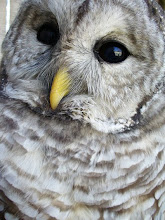
In spring and early summer, staff and birds are getting ready for “flying season”, which is an important time of the year at the Raptor Centre. During the winter months, our non-releasable birds are kept at a weight that allows them to be comfortable and cozy despite the cold weather, since many of them live outside year round. Because of dangerously low temperatures, we do not flight train our birds in winter-- instead, we allow them to exercise themselves. Summer is a different matter, and active training in the summer months keeps our residents healthy and fit. It also allows for an exciting flying demonstration-- it's truly amazing to have a Barn Owl ghost silently right over your head! Although there’s a lot of work involved, it’s sometimes hard to tell who is having more fun-– the staff, the public, or the birds!
 Getting the birds in shape for flying season after they have been off on winter vacation is all about healthy diet and exercise. We start by weighing the birds daily to ensure that they are in good condition and to monitor weight changes as they occur. Then we begin actively exercising the birds inside the Raptor Centre—this is done by getting them to jump on command to a gloved fist for a food reward. Depending on the bird, this can be more difficult than you’d think! It requires repetition, patience (from both bird and handler), and trust. All of our birds are trained with positive reinforcement techniques.
Getting the birds in shape for flying season after they have been off on winter vacation is all about healthy diet and exercise. We start by weighing the birds daily to ensure that they are in good condition and to monitor weight changes as they occur. Then we begin actively exercising the birds inside the Raptor Centre—this is done by getting them to jump on command to a gloved fist for a food reward. Depending on the bird, this can be more difficult than you’d think! It requires repetition, patience (from both bird and handler), and trust. All of our birds are trained with positive reinforcement techniques.After the birds are performing reliably indoors, it’s time to go out to the Flyway. The birds do short flights at first, getting their bearings, and then we increase the distance as days go by until they are flying the full length of the Flyway. Before you know it, they're ready for show time! For a bird like Ellie the Turkey Vulture, who has been part of our flying demonstrations for many years, getting back into summer flying is an easy task – all she needs to do is get rid of some winter weight and build her strength back up. However, for birds like our soon-to-be-named
 American Kestrel—who has never done this before—it can be a big job. He has had to learn how to land on the glove, how to navigate the Flyway, where the perches are located, what to do when there is a person sitting between him and the perch he wants to fly towards, and how to concentrate on his flying when there are so many other interesting things going on around him. That said, he is doing extremely well so far, and we are excited to show off his flying skills this summer!
American Kestrel—who has never done this before—it can be a big job. He has had to learn how to land on the glove, how to navigate the Flyway, where the perches are located, what to do when there is a person sitting between him and the perch he wants to fly towards, and how to concentrate on his flying when there are so many other interesting things going on around him. That said, he is doing extremely well so far, and we are excited to show off his flying skills this summer! Our flying demonstrations officially start on July 1st and continue until Labour Day, but some lucky park visitors have already been treated to sneak peeks during their visits. Our birds hope to see you out at the park soon, so that they can show off their flying skills! Well, except for Scout the Merlin, who would actually prefer it if nobody but his favorite trainer watched him fly, but that’s a story for another blog entry....
You can find information on Raptor Centre Show Times by clicking here.
See you on the trails!

